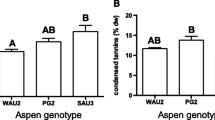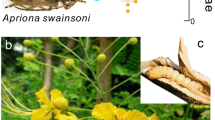Abstract
Metabolomics has increasingly led to important insights in chemical ecology by identifying environmentally relevant small molecules that mediate inter-organismal interactions. Nevertheless, the application of metabolomics to investigate interactions between phytophagous insects and their microbial symbionts remains underutilized. Here, we investigated the metabolomes of the bacteriomes (organs bearing symbiotic bacteria) isolated from natural populations of five species of xylem-feeding insects. We identified three patterns. First, the metabolomes varied among the five species, likely influenced by insect phylogeny, food plant and taxonomic identity of the symbionts. Second, the ratio of glutamine: glutamate in the bacteriomes was 0.7–3.6 to 1, indicative of nitrogen-sufficient metabolism and raising the possibility that the insect sustains nitrogen-enriched status of the bacteriomes despite the nitrogen scarcity of the xylem diet. Finally, bacteriomes from insect species bearing genetically-similar symbionts displayed limited variation in their metabolomes, suggesting that the metabolic pattern of the bacteriome metabolic pools is correlated with the genetic repertoire of the symbionts. Altogether, these metabolomic patterns yield specific hypotheses of underlying processes that are testable by wider sampling of natural populations and experimental study.






Similar content being viewed by others
References
Akman Gündüz E, Douglas A (2008) Symbiotic bacteria enable insect to use a nutritionally inadequate diet. Proc Royal Soc B: Biological Sciences 276:987–991
Andersen PC, Brodbeck BV, Mizell RF III (1989) Metabolism of amino acids, organic acids and sugars extracted from the xylem fluid of four host plants by adult Homalodisca coagulata. Entom Exp et Appl 50:149–159
Ankrah NY, Chouaia B, Douglas AE (2018) The cost of metabolic interactions in symbioses between insects and bacteria with reduced genomes. mBio. 9:e01433–e01418
Aristilde L, Reed ML, Wilkes RA, Youngster T, Kukurugya MA, Katz V, Sasaki CR (2017) Glyphosate-induced specific and widespread perturbations in the metabolome of soil Pseudomonas species. Frontiers Environ Sci 5:34
Bell-Roberts L, Douglas AE, Werner GD (2019) Match and mismatch between dietary switches and microbial partners in plant sap-feeding insects. Proc Royal Soc B 286:20190065
Bennett GM, Moran NA (2015) Heritable symbiosis: the advantages and perils of an evolutionary rabbit hole Proc. Natl Acad Sci 112:10169–10176
Ben-Yosef M, Pasternak Z, Jurkevitch E, Yuval B (2015) Symbiotic bacteria enable olive fly larvae to overcome host defences. Royal Soc Open Sci 2:150170
Bernays E, Graham M (1988) On the evolution of host specificity in phytophagous arthropods Ecology 69:886–892
Bi J, Castle S, Byrne F, Tuan S, Toscano N (2005) Influence of seasonal nitrogen nutrition fluctuations in orange and lemon trees on population dynamics of the glassy-winged sharpshooter (Homalodisca coagulata). J Chem Ecol 31:2289–2308
Bi J, Castle S, Toscano N (2007) Amino acid fluctuations in young and old orange trees and their influence on glassy-winged sharpshooter (Homalodisca vitripennis) population densities. J Chem Ecol 33:1692–1706
van den Bosch TJ, Welte CU (2017) Detoxifying symbionts in agriculturally important pest insects. Microbial Biotechnol 10:531–540
Brodbeck BV, Mizell RF, French WJ, Andersen PC, Aldrich JH (1990) Amino acids as determinants of host preference for the xylem feeding leafhopper, Homalodisca coagulata (Homoptera: Cicadellidae). Oecologia 83:338–345
Brodbeck BV, Andersen PC, Oden S, Mizell RF (2014) Preference-performance linkage of the xylem feeding leafhopper, Homalodisca vitripennis (Hemiptera Cicadellidae). Environ Entomol 36:1512–1522
Buchner P (1965) Endoymbiosis of animals with plant microorganisms. John Wiley and Sons, Chichester, United Kingdom
Burke G, Fiehn O, Moran N (2010) Effects of facultative symbionts and heat stress on the metabolome of pea aphids. The ISME journal 4:242
Ceja-Navarro JA et al (2015) Gut microbiota mediate caffeine detoxification in the primary insect pest of coffee Nature Comm 6:7618
Chung SH et al. (2013) Herbivore exploits orally secreted bacteria to suppress plant defenses Proc Natl Acad Sci. 110:15728-15733
Clasquin MF, Melamud E, Rabinowitz JD (2012) LC-MS data processing with MAVEN: a metabolomic analysis and visualization engine. Current protocol. Bioinformatics 37:14.11. 11–14.11. 23
De Hoon MJ, Imoto S, Nolan J, Miyano S (2004) Open source clustering software. Bioinformatics 20:1453–1454
Douglas AE (2009) The microbial dimension in insect nutritional ecology. Funct Ecol 23:38–47
Douglas AE (2015) Multiorganismal insects: diversity and function of resident microorganisms. Annu Rev Entomol 60:17–34
Douglas AE (2016) How multi-partner endosymbioses function. Nature Rev Microbiol 14:731–743
Douglas AE (2018) Omics and the metabolic function of insect–microbial symbioses. Current Opinion Insect Sci 29:1–6
Flynn KJ, Dickson DM, Al-Amoudi OA (1989) The ratio of glutamine: glutamate in microalgae: a biomarker for N-status suitable for use at natural cell densities. J. Plankton Res 11:165–170
Hansen AK, Moran NA (2014) The impact of microbial symbionts on host plant utilization by herbivorous insects. Mol Ecol 23:1473–1496
Ikeda TP, Shauger AE, Kustu S (1996) Salmonella typhimurium apparently perceives external nitrogen limitation as internal glutamine limitation. J. Mol Biol 259:589–607
Jang C, Chen L, Rabinowitz JD (2018) Metabolomics and isotope tracing. Cell 173:822–837
Kikuchi Y, Hosokawa T, Fukatsu T (2007) Insect-microbe mutualism without vertical transmission: a stinkbug acquires a beneficial gut symbiont from the environment every generation. Appl Envir Microbiol 73:4308–4316
Klein AR, Barzen-Hanson KA, Aristilde L (2019) A non-derivatized method for simultaneous quantitation of proteinogenic, urea-cycle, and acetylated amino acids by liquid chromatography–high-resolution mass spectrometry. Environ Chem Lett:1–7
Koga R, Bennett GM, Cryan JR, Moran NA (2013) Evolutionary replacement of obligate symbionts in an ancient and diverse insect lineage. Environ Microbiol 15:2073–2081
Kuhlisch C, Pohnert G (2015) Metabolomics in chemical ecology. Nat Prod Rep 32:937–955
Lankadurai BP, Nagato EG, Simpson MJ (2013) Environmental metabolomics: an emerging approach to study organism responses to environmental stressors. Environ Rev 21:180–205
Matsuura Y et al (2018) Recurrent symbiont recruitment from fungal parasites in cicadas. Proc Natl Acad Sci 115:E5970–E5979
McCutcheon JP, Moran NA (2010) Functional convergence in reduced genomes of bacterial symbionts spanning 200 my of evolution. Genome Biol Evol 2:708–718
McCutcheon JP, McDonald BR, Moran NA (2009a) Convergent evolution of metabolic roles in bacterial co-symbionts of insects. Proc Natl Acad Sci 106:15394–15399
McCutcheon JP, McDonald BR, Moran NA (2009b) Origin of an alternative genetic code in the extremely small and GC–rich genome of a bacterial symbiont. PLoS Genet 5:e1000565
Melamud E, Vastag L, Rabinowitz JD (2010) Metabolomic analysis and visualization engine for LC− MS data. Anal Chem 82:9818–9826
Mooney KA, Pratt RT, Singer MS (2012) The tri-trophic interactions hypothesis: interactive effects of host plant quality, diet breadth and natural enemies on herbivores. PLoS One 7:e34403
Newsholme P, Procopio J, Lima MMR, Pithon-Curi TC, Curi R (2003) Glutamine and glutamate—their central role in cell metabolism and function. Cell Biochem Funct 21:1–9
Oliver KM, Smith AH, Russell JA (2014) Defensive symbiosis in the real world–advancing ecological studies of heritable, protective bacteria in aphids and beyond. Funct Ecol 28:341–355
Pate J (1980) Transport and partitioning of nitrogenous solutes. Annu Rev Plant Physiol 31:313–340
Price PW, Bouton CE, Gross P, McPheron BA, Thompson JN, Weis AE (1980) Interactions among three trophic levels: influence of plants on interactions between insect herbivores and natural enemies. Annu Rev Ecol System 11:41–65
Price DR, Feng H, Baker JD, Bavan S, Luetje CW, Wilson AC (2014) Aphid amino acid transporter regulates glutamine supply to intracellular bacterial symbionts. Proct Natl Acad Sci 111:320–325
R Core Team (2016) R: a language and environment for statistical computing. R Foundation for Statistical Computing, Vienna, Austria
Raven JA (1983) Phytophages of xylem and phloem: a comparison of animal and plant sap-feeders. In: Adv Ecol res, vol 13. Elsevier, pp 135-234
Saldanha AJ (2004) Java Treeview—extensible visualization of microarray data. Bioinformatics 20:3246–3248
Sardans J, Penuelas J, Rivas-Ubach A (2011) Ecological metabolomics: overview of current developments and future challenges. Chemoecol 21:191–225
Sedio BE (2019) Recent advances in understanding the role of secondary metabolites in species-rich multitrophic networks. Current Opin Insect Sci
Shigenobu S, Wilson AC (2011) Genomic revelations of a mutualism: the pea aphid and its obligate bacterial symbiont. Cellu Molec Life Sci 68:1297–1309
Sudakaran S, Kost C, Kaltenpoth M (2017) Symbiont acquisition and replacement as a source of ecological innovation. Trends Microbiol
Van Arnam EB, Currie CR, Clardy J (2018) Defense contracts: molecular protection in insect-microbe symbioses. Chem Soc Rev 47:1638–1651
Vidal MC, Murphy SM (2018) Bottom-up vs. top-down effects on terrestrial insect herbivores: a meta-analysis. Ecol Lett 21:138–150
Waltmann A, Willcox AC, Balasubramanian S, Borrini Mayori K, Mendoza Guerrero S, Salazar Sanches RS, Roach J, Condori Pino C, Gilman RH, Juliano JJ, Levy MZ, Meschnick SR, Bowman NM (2019) Hindgut microbiota in laboratory-reared and wild Triatoma infestans. PLoS Neglected Trop Diseases 13:e0007383
Wang Y, Carolan JC, Hao F, Nicholson JK, Wilkinson TL, Douglas AE (2010) Integrated metabonomic− proteomic analysis of an insect− bacterial symbiotic system. J Prot Res 9:1257–1267
Wickham H (2016) ggplot2: elegant graphics for data analysis. Springer
Winans NJ, Chouaia B, Chaston JC, Douglas AE, Newell PD (2017) A genomic investigation of ecological differentiation between free-living and Drosophila-associated bacteria. Mol Ecol 26:4536–4550
Wohlhueter R, Schutt H, Holzer H (1973) Regulation of glutamine synthesis in vivo in E. coli. In: the enzymes of glutamine metabolism. Academic Press, New York, pp 45–64
Wu D et al (2006) Metabolic complementarity and genomics of the dual bacterial symbiosis of sharpshooters. PLoS Biol 4:e188
Xia J, Sinelnikov IV, Han B, Wishart DS (2015) MetaboAnalyst 3.0—making metabolomics more meaningful. Nucleic Acids Res 43:W251–W257
Acknowledgements
We thank Jason Dombroskie (Cornell University Insect Collection) for assistance with insect identification and Frances Blow, Alyssa Bost, Seung H. Chung, Lu Liu, Tadeo Kaweesi and Dantong Zhu for assistance with insect dissections. This study was funded by National Science Foundation grant IOS-1354743.
Author information
Authors and Affiliations
Contributions
N.Y.D.A., L.A., and A.E.D. designed research; N.Y.D.A. and F.Z. performed research; R.A.W. and L.A. performed mass spectrometry analysis; N.Y.D.A. analyzed data; N.Y.D.A. and A.E.D. wrote the first draft of the paper; manuscript revisions made by all authors.
Corresponding authors
Ethics declarations
Conflict of Interest
The authors declare that they have no conflict of interest.
Ethical Approval
This article does not contain any studies with human participants or animals performed by any of the authors.
Electronic supplementary material
Tables S1
(XLSX 9 kb)
Tables S2
(XLSX 12 kb)
Tables S3
(XLSX 10 kb)
Tables S4
(XLSX 9 kb)
Tables S5
(XLSX 21 kb)
Figure S1
Absolute quantification of select central carbon, nucleotide and non-proteinogenic amino acid metabolites in the combined bacteriomes of the five insect species. Absolute metabolite concentrations were autoscaled (mean-centered and divided by the standard deviation of each variable) prior to statistical analysis. Significantly different (P < 0.05) samples by Tukey’s HSD posthoc test indicated by different letters. Plots with no letters represent metabolites with missing values that were excluded from analysis of variance (ANOVA). (PDF 514 kb)
Figure S2
Absolute quantification of select central carbon, nucleotide and non-proteinogenic amino acid metabolites in Sulcia- containing bacteriomes of spittlebug species. Absolute metabolite concentrations were autoscaled (mean-centered and divided by the standard deviation of each variable) prior to statistical analysis. Significantly different (P < 0.05) samples by Tukey’s HSD posthoc test indicated by different letters. Plots with no letters represent metabolites with missing values that were excluded from analysis of variance (ANOVA). (PDF 458 kb)
Rights and permissions
About this article
Cite this article
Ankrah, N.Y.D., Wilkes, R.A., Zhang, F.Q. et al. The Metabolome of Associations between Xylem-Feeding Insects and their Bacterial Symbionts. J Chem Ecol 46, 735–744 (2020). https://doi.org/10.1007/s10886-019-01136-7
Received:
Revised:
Accepted:
Published:
Issue Date:
DOI: https://doi.org/10.1007/s10886-019-01136-7




